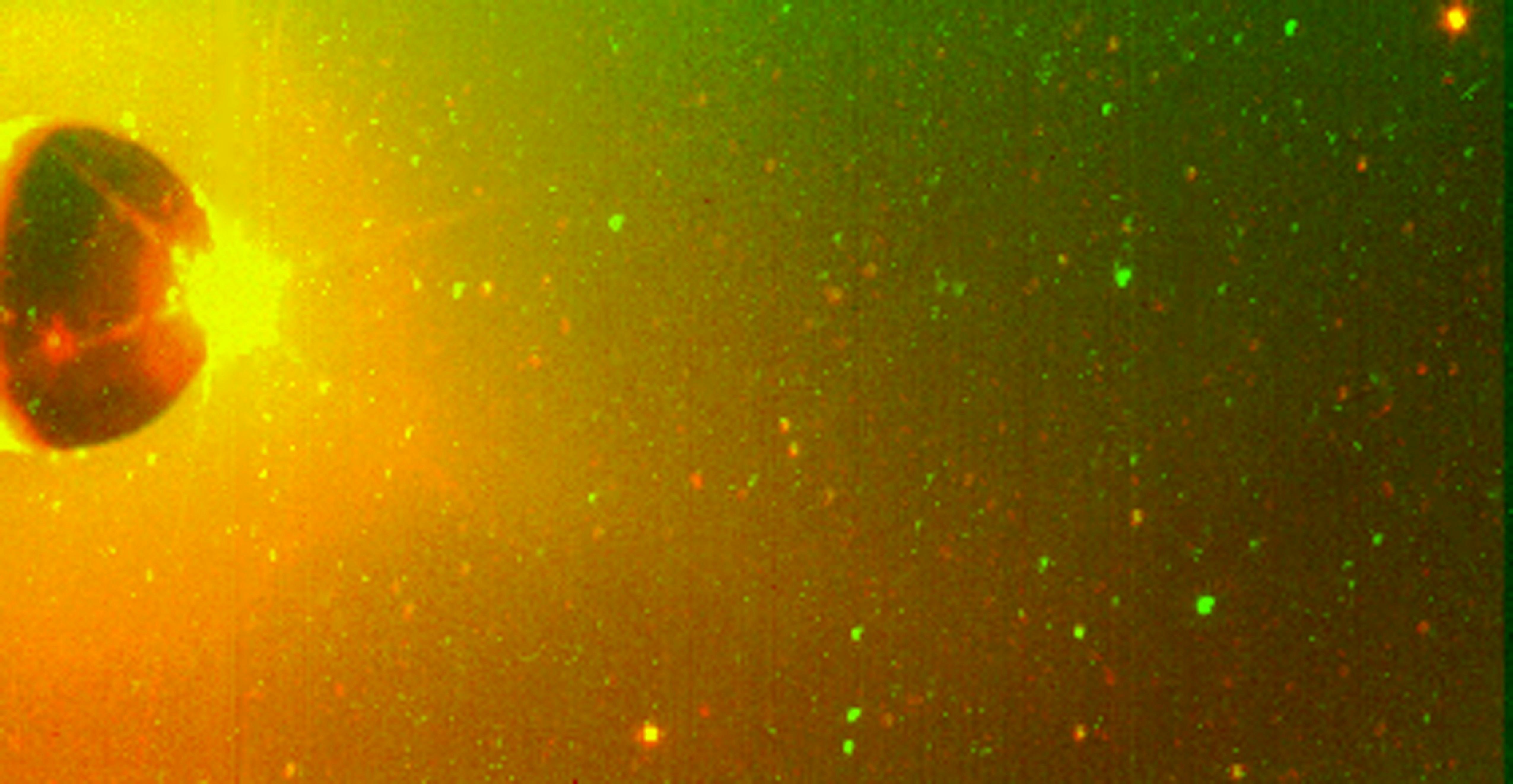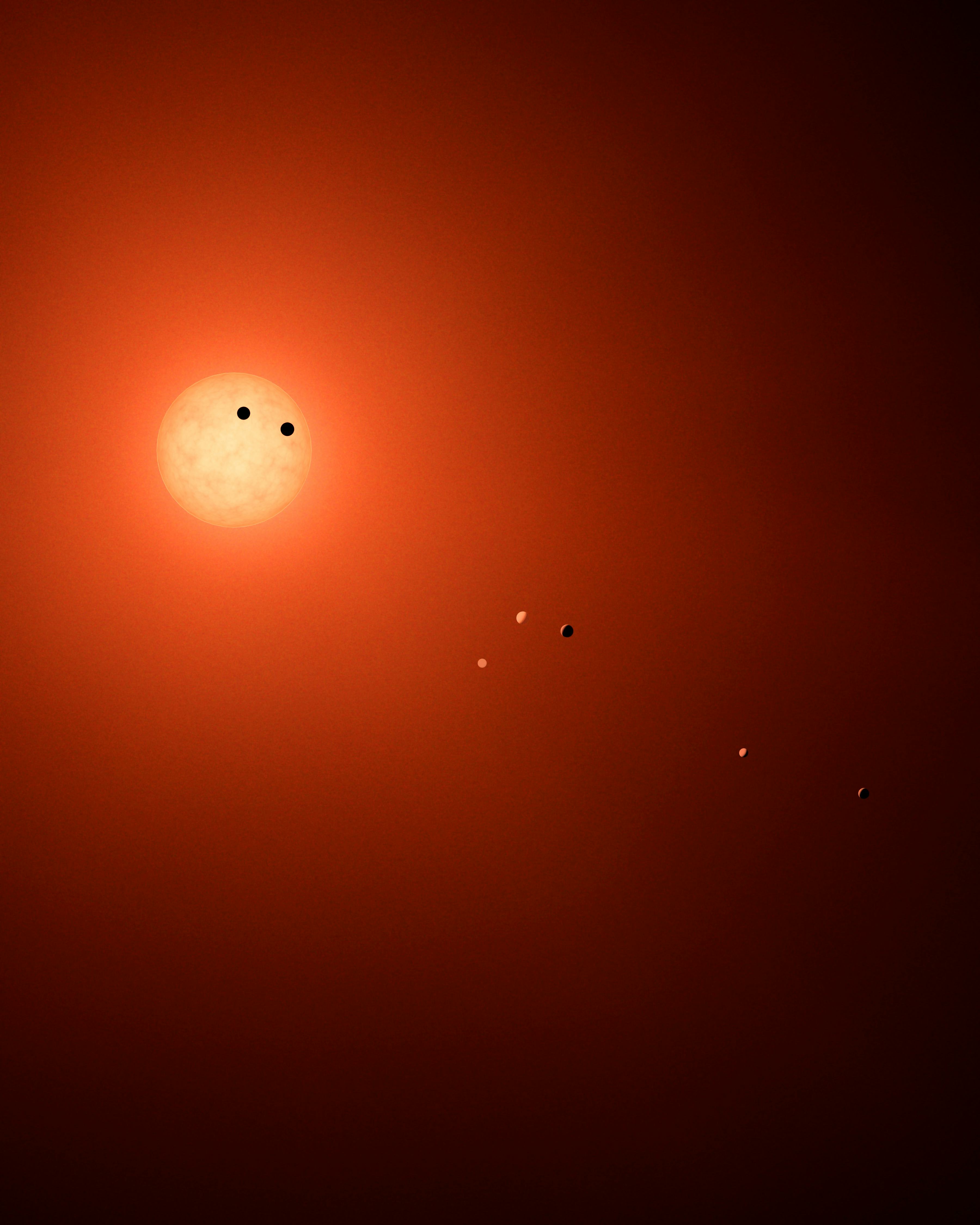
Recent data from the James Webb Space Telescope (JWST) suggests that a planet orbiting a small, red star 35 light years away may have a thick, sulfurous atmosphere, fueled by constant volcanic eruptions. Other astronomers say it’s too soon to tell.
The data, and the debate, shed light on how difficult it still is to make sense of the atmospheres of distant exoplanets. Banerjee and colleagues published their work in The Astrophysical Journal Letters.

A Volcanic Hellscape With A Toxic Atmosphere
Banerjee and colleagues used JWST’s Near InfraRed Spectrometer (NIRSpec) to measure the spectrum of light from planet L98-59d as it passed in front of its star, which seems to reveal an atmosphere made mostly of sulfur dioxide and some hydrogen sulfide. For a smallish planet orbiting much too close to its star for life to exist, that’s a surprise; observations of planets at similar distances around similar stars, like TRAPPIST-1, have mostly turned up bare rock so far. But Banerjee and colleagues suggest that if the planet were a volcanic hellscape like Io, those volcanoes could pump out enough sulfurous fumes to keep the planet swathed in a thick, noxious atmosphere despite its nearby star’s constant bombardment of radiation and plasma.
Here in our own Solar System, Jupiter’s moon Io boasts hundreds of volcanoes which constantly spew fire and gases into the vacuum of space surrounding the moon. The inner fire that fuels this constant state of apocalypse comes from tidal forces powerful enough to pull on the very rock that makes up Io, keeping its interior hot, molten, and unsettled. And those tidal forces are the result of a strange alignment, called an orbital resonance, between Io and its sibling moons: Every time Io makes two orbits around Jupiter, it aligns with Europa; every fourth orbit, Io aligns with Europa and Ganymede.
Similar forces may be churning deep inside L98-59d, which is in a similar orbital resonance with the two innermost planets in its star system.
“Since L 98-59 d is also possibly tidally heated and tidal heating could lead to volcanoes, which could then lead to SO2, we can draw this comparison between the two bodies,” says Banerjee. “The atmosphere of L 98-59 d, if it is indeed what the current data suggests, would be much thicker and heavier than that on Io.
According to Banerjee and colleagues, that could drive enough volcanism to blanket the planet in sulfur dioxide and hydrogen sulfide.
But other planetary scientists aren’t so sure, and that underscores how difficult it is to understand what we’re seeing when we look at an exoplanet’s atmosphere from 35 light years away, even with a powerful and sensitive telescope like JWST.

Imaging Exoplanet Atmospheres Is Possible, But Still Not Easy
“The era of detection and characterization of atmospheres around rocky exoplanets is now here,” write Banerjee and colleagues in their recent paper. And that’s true, but it’s not always as straightforward as astronomers might hope.
Banerjee describes the data as “very noisy and tentative,” and in their paper, Banerjee and colleagues note that their conclusions need to be confirmed by more observations.
To get the data that points, or seems to point, to an atmosphere of sulfur gases around L98-59d, Banerjee and colleagues couldn’t just look right at the planet. Instead, they had to wait for the planet to cross in front of its star, then look specifically at the spectrum of light around the very edges of the planet’s silhouette. That narrow ring marks where starlight might filter through the planet’s atmosphere, if there’s an atmosphere there. And it’s tiny compared to the rocky bulk of the planet and the huge, bright glare of the star.
It’s difficult, even with sophisticated computer programs like the one Banerjee and colleagues used, to be sure how much of the light they’re seeing is a chemical fingerprint of L98-59d’s atmosphere and how much is contamination from the star. That’s something that’s also challenged astronomers searching for atmospheres around the worlds of the TRAPPIST-1 system, and other rocky planets orbiting red dwarf stars.
“We don't fully understand the details of stellar contamination. We don't know it the best at longer wavelengths,” says planetary scientist Nick Wogan, who was not involved in the current study, referring to the infrared light in which JWST sees the universe.
The alternative is to watch the planet pass behind its star offering a brief glimpse of the side with daylight, which usually faces toward the star and away from Earth. This is how other teams of astronomers have ruled out thick atmospheres on TRAPPIST-1b and TRAPPIST-1c. And future observations of L98-59d might do that, too.

How Sure Are We About L98-59’s Hellish Atmosphere?
Meanwhile, other astronomers that Inverse spoke to are taking the idea of a volcano world with a sulfurous atmosphere with a grain of salt. Astrophysicist Thomas Greene, who wasn’t involved in the current study but has been part of several rounds of observations of TRAPPIST-1b and TRAPPIST-1c, bluntly tells Inverse, “Unfortunately the data are too poor to conclude much of anything about this planet.”
Wogan is more equivocal:
“It's not like it's the most convincing detection in the world,” he says. “Given the planet's density, it seems like there should be something [of an atmosphere] there, but I'm not sure if they detected what is there or if they just have some noisy data.”
For one thing, the atmosphere doesn’t look quite like what you’d expect a planet full of volcanoes to be spewing out.
“The volcanism hypothesis from tidal heating is reasonable, but I would just expect there to be other gases," says Wogan. "Generally, magma contains quite a lot of carbon — an amount comparable to sulfur. Volcanoes in the Solar system produce carbon monoxide and carbon dioxide. Venus has SO2, but the dominant gas is carbon dioxide. On Earth, there's all sorts of different kinds of volcanism; water vapor is the most dominant volcanically-produced gas. One of my knee-jerk reactions was ‘Where are the other gases?’”
And then there’s the density of the planet itself. At 1.5 times Earth’s width and nearly twice its mass, L98-59d is much too light to be made of solid rock and metal. Instead, astronomers say that at least a third of the planet’s mass may be water, likely in the form of water vapor, according to Wogan, because the planet gets too much heat from its star to keep water from evaporating.
But there’s no water vapor in its atmosphere, according to Banerjee and colleagues.
“We don’t see any signs of significant amounts of gaseous H2O,” says Banerjee. “While the current (again, very noisy and tentative) data suggest H2S, (and if so, no water) we can’t say that conclusively.”
Explaining the planet’s density while also explaining the apparent lack of water is a challenge Banerjee and colleagues will have to wrangle with, probably by gathering more data with different instruments on JWST, building new computer simulations, and finding out how the two line up.
What’s Next?
“It's great to throw ideas out there so we can think about them,” says Wogan. “It's hard to make definitive claims at this point with this data, but it will be an interesting one to keep track of in the next probably 3 years.”
Banerjee and colleagues are already planning to examine the planet at least twice more with JWST: once more with NIRSpec, in a different set of wavelengths, and once with the Near InfraRed Slitless Spectrograph (NIRISS). They’re also hoping the Space Telescope Science Institute, the organization that operates JWST and decides which astronomers get telescope time for which projects, will allocate some time for them to look at L98-59 in even longer infrared wavelengths with the Mid-InfraRed Instrument (MIRI).
If Banerjee and colleagues do see the same signs of a dense sulfurous atmosphere around L98-59 with JWST’s other instruments, that would lend their idea a lot more weight, even as it pushes them to explain how such an atmosphere would fit into the puzzle of the planet’s density and the absence of water and other gases. It would also reveal something we’re already learning, bit by bit: the universe is a weird place, and it’s weird in a dazzling array of different ways.
“The rocky planets in the Solar System all have different atmospheric compositions,” write Banerjee and colleagues. “The study of such atmospheres in exoplanetary systems could unlock a rich diversity of unexplored chemistries.”







